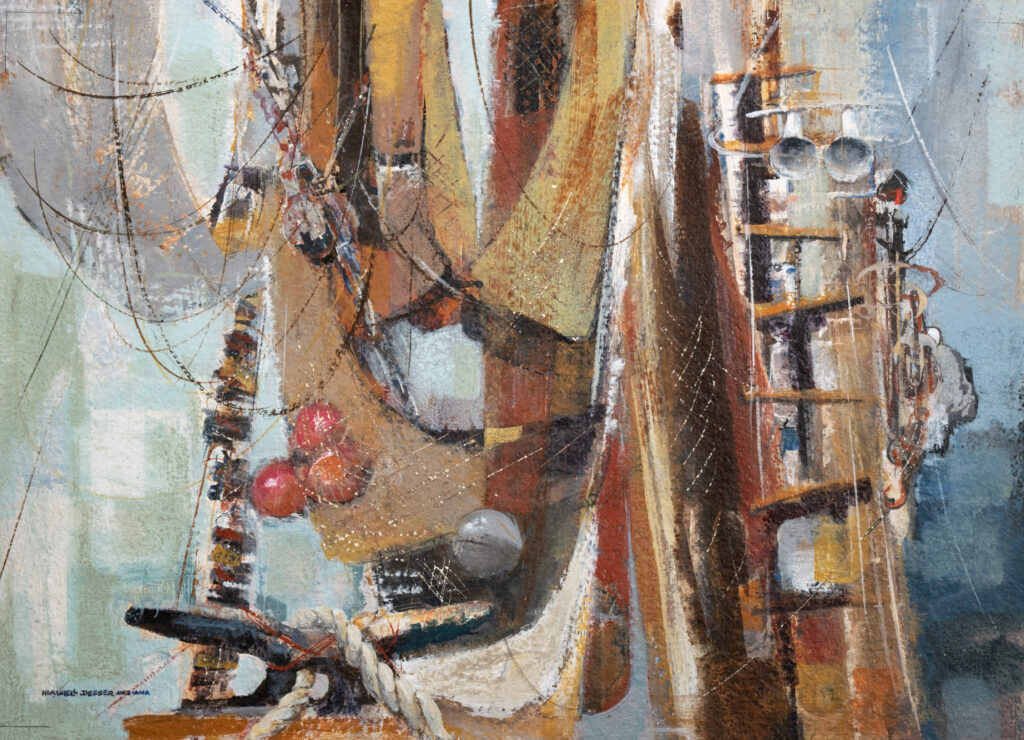

Maxwell Desser’s studio was stacked with art books splattered with his paint and disintegrating from study and admiration. He began as a commercial artist, a graphic designer, and an inventive producer of crawl filmstrips, but came to dedicate himself to fine art. Surveying artistic movements from realism to abstraction, he settled on the almost-abstract. Though his brushwork borrowed from Expressionists and Abstract Expressionists, Cubists, Impressionists, and Surrealists, his style was his own and once you come to know it you always recognize a Desser.
The painter Carlton Plummer told Watercolor Artist magazine that he had “long admired Maxwell’s painting with its strong design. Maxwell’s work was fairly abstract, but he had an open mind.” The artist Paul Jackson said simply, “Desser should be remembered as one of the greatest American artists.”
Desser painted in series — Harbor Patterns, Montauk, Music — and in smaller clusters including chess, cityscapes, and football. His almost-abstracts contain recognizable objects — boats, rigging, cities, musical instruments — yet they are not necessarily oriented by gravity: His painting “Music Series, Seriatim #54,” for one, was inadvertently published upside down in a textbook; “Bewitched” was painted vertically, but signed and hung horizontally. His pure abstracts relate even less to up, down, and sideways: several were signed on adjacent edges and framed with two hanging wires perpendicular to each other, giving the possessor a role in the art.
Some artists paint with a message, use their canvas for illustration, or disburse considerable text to explain what they’d done. Desser didn’t. For Desser, art, like a verified fact, does not change just because we learn a backstory. Paintings are what you see, independent of how they got that way and regardless of what is said about them. Ask him what he intended in a painting, and he’d ask what you saw. In person he loved telling stories, but he felt his paintings should speak on their own.
In which case, you might already have read too much.
But he did talk about art, and he spoke openly about his process:
There are many theories on how to approach a painting. Some artists see the finished work in their mind’s eye before lifting the brush. I never do. I design and paint as I go along. I change. I correct. I experiment. I splash. I often lose what I’m doing, and then, if I’m lucky, I find it again. I thrive on accident. But I never forget design elements, color relations, positive and negative space and, above all, plasticity. On every painting I sweat, I struggle, I get mad at myself, and at times I even hate what I’m doing. And I envy the artist who says every moment of painting is a moment of joy.
While the product is purely visual, the process is not necessarily so. About the advent and evolution of his Music Series, he wrote that:
I had always been enchanted by the graceful shape of musical instruments. It occurred to me that Picasso and Braque concentrated on the guitar. They stretched it, bent it, distorted, exaggerated, and abstracted it so beautifully. Why couldn’t Desser try that, but take on the whole orchestra, cut it up, juggle it around, break it into sections, abstract it. After a few attempts, things began to click. Now, I’m attempting to expand, bring sound into the picture. Why not try to interpret music in the design? Listen to it, absorb it, feel it. Does it whisper or shout? Is it thin or bulky? Is it rough like a dry-brush loaded with juicy color and swung across a rough Fabriano surface or is it smooth like a delicate wash? Is it blue, green, red? Does it charge blindly ahead or is there a sudden change of pace — quiet, peaceful?
Click HERE to read reflections on the artist, or choose a gallery to view:
MEMBERSHIPS:
● American Watercolor Society, https://americanwatercolorsociety.org/
Dolphin Fellow.
● National Academy of Design, https://nationalacademy.org/
National Academician.
● Audubon Artists, https://audubonartists.org/
● Allied Artists of America, https://www.alliedartistsofamerica.org/
● National Society of Painters in Casein and Acrylic,
https://www.nationalsocietyofpaintersincaseinandacrylic.com/
● [additional entries to come]
____________________________
Credits and Attributions:
● The quotes of artists Carlton Plummer and Paul Jackson are from Watercolor Magic, Yearbook 2001, pp 62-63. The publication is now called Watercolor Artist.
● The first block quote is from the “1987 Special Tribute to Maxwell Desser,” 37th Annual Open Exhibition, Knickerbocker Artists of New York.
● The second block quote is from the American Watercolor Society, “Vignettes of AWS People,” ellipses omitted.
Contact:






